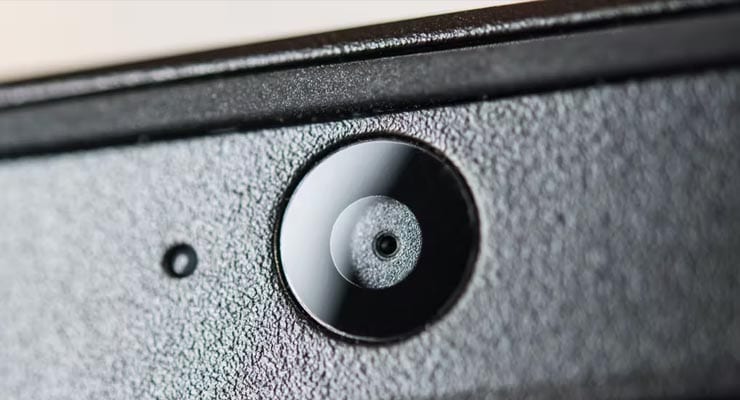How to protect your webcam from hackers – 6 simple tips
There is a contemporary online adage that says if something is connected to the Internet, it can potentially be hacked. And this is also true of a person’s webcam.
The annals of Cybersecurity are littered with stories of people getting their webcams hacked, thus allowing cyber-crooks to spy on their activities. The reality is that with the rising frequency of highly-sophisticated state-sponsored intrusions, just about anyone could potentially fall victim to having their laptop webcam compromised.
(By the way, if you’ve ever received an email out-of-the-blue from someone claiming to be a hacker saying they hacked your webcam, obtained compromising footage of you, and are now demanding a ransom payment, that’s still probably a complete bluff. We get about 20 of those emails every day. Read here for more information on that scam.)
Fortunately there are some simple steps anyone can take to greatly increase the security of their webcam, and we go through some here.
1. Keep your webcam software up-to-date
We may give a host of different software or apps permission to access our webcam, including Microsoft Teams and Zoom, both of which have seen their popularity surge since the pandemic. However, if these programs suffer from vulnerabilities, it could mean cyber-criminals finding an easy route to our webcam. For example in 2019, Zoom users on Mac computers could be tricked into clicking a link that would automatically put them into a “meeting” with a cyber-crook, giving that crook instant access to the victim’s webcam.
Zoom fixed the exploit soon after, but it demonstrates the importance of keeping any software that uses our webcam updated to ensure that any security fixes are immediately deployed on our devices. So for users of Teams, Skype, Zoom or if its the manufacturer of the webcam itself – if you’re prompted to do an update, make sure you do it.
Sponsored Content. Continued below...
2. Security software
It is perhaps of little surprise that having good security software is an important step to keeping your webcam safe. Many webcam intrusions happen because of malware attacks, which allow criminals to install malicious software specifically tailored to access a webcam.
In this respect, the advantage of having good security software can be two-fold. Firstly, it can help identify the malware in the first place and remove it (or prevent it from installing in the first place). And secondly, good security software will likely have a webcam feature that specifically protects your webcam from being accessed by software without the relevant permissions.
If you already consider yourself pretty cybersecurity savvy, you probably already have some free security software installed already. For everyone else, our recommended premium security software includes a webcam protection feature. You can get more information here.
Also, remember to run regular full system scans with your security software.
3. Practice good security habits
Practising good Cybersecurity basics will protect you against nearly all online threats, including ones looking to access your webcam.
Most malware and phishing attacks – the same attacks that could often be used to illicitly gain access to a webcam – can be avoided simply by…
- Not opening email attachments on emails.
- Not clicking on links in emails you were not expecting.
- Never downloading files to your computer unless you are completely confident it is safe to do so.
Sponsored Content. Continued below...
4. Cover your webcam (and close your laptop.)
Sometimes the simplest tips are the most effective, and as a last line of defence, nothing can beat physically covering your webcam up for ultimate peace of mind. Even Facebook founder Mark Zuckerberg and former-FBI director James Comey practise this particular privacy tip.
There are plenty of stick-on sliding clips that can allow you to do this, such as the Webcam cover from CloudValley for around $7. (Reading from the UK? Click here instead.) Alternatively nothing beats a bit of black masking tape for the cheapest solution!
This way, even if sophisticated intruders do manage to get past your defences, they’re still not going to be able to see anything.
On a similar note, if you’re not using your laptop, close the lid to hide the webcam.
5. Only use reputable repair centres
If it’s time to get the laptop repaired, only use well-known and established repair centres with a good reputation, or people that you trust. Whilst rare, incidents have occurred of less-than-reputable repair shops installing malware onto devices.
6. Avoid tech support themed scams
Tech-support themed scams are often linked to attacks on webcams because they often dupe a victim into installing remote desktop software.
Remote desktop software is a type of software that allows an attacker to take full control of a victim’s computer. An attacker will claim the victim needs to install the software so the attacker – posing as a tech support agent – can fix the victim’s computer (such as to remove viruses.)
Never trust unexpected emails, messages or phone calls claiming to be from someone offering technical support. This is especially true if that person claims you are infected with viruses or will have your Internet disconnected unless you take action. You can read more about technical support scams here.
Continued below...
Thanks for reading, we hope this article helped, but before you leave us for greener pastures, please help us out.
We're hoping to be totally ad-free by 2025 - after all, no one likes online adverts, and all they do is get in the way and slow everything down. But of course we still have fees and costs to pay, so please, please consider becoming a Facebook supporter! It costs only 0.99p (~$1.30) a month (you can stop at any time) and ensures we can still keep posting Cybersecurity themed content to help keep our communities safe and scam-free. You can subscribe here
Remember, we're active on social media - so follow us on Facebook, Bluesky, Instagram and X
